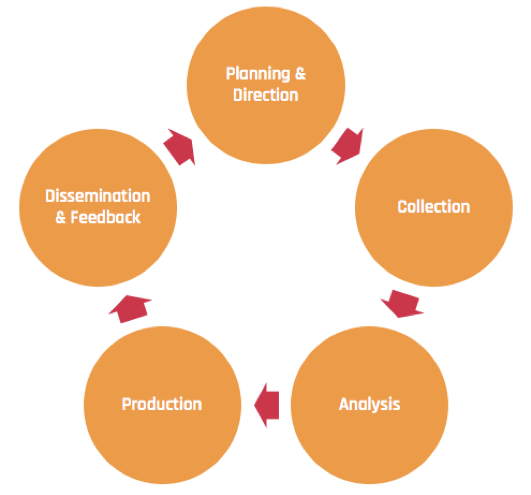A growing number of organizations across the public and private sectors are recognizing insider threat as a critical area of concern. In response, many are taking measures to defend assets from risks posed by employees and trusted third parties.
Insiders pose unique challenges for defenders. Perimeter security tools, for example, are unlikely to hamper privileged insiders. Combating insider threats requires security teams to understand which of their organization’s assets insiders may threaten, and how. Obtaining these insights requires an insider threat program (ITP) supported by a threat intelligence operation.
Let’s examine how the intelligence cycle can help ITPs more effectively identify, investigate, and mitigate insider threats by identifying knowledge gaps, collecting and analyzing information to address those gaps, and leveraging their findings to inform a course of action.

Step 1: Planning & Direction
During this first step of the intelligence cycle, intelligence requirements are developed that define the direction and objective(s) of the insider threat program. These IRs should address critical knowledge gaps with respect to the ITP’s ability to identify, investigate, and/or mitigate an insider threat.
To illustrate this process, let’s walk through a hypothetical scenario. Suppose a consumer electronics company decides to establish an ITP after a competitor faced considerable financial and reputational damages when designs for an upcoming product were leaked after being sold by a rogue employee a dark-web marketplace. To protect its organization from facing a similar incident, the ITP launches an intelligence operation with the following IRs:
- IR No. 1: What communication platforms and/or methods are actors using to recruit employees to carry out malicious activity?
- IR No. 2: Are external threat actors actively attempting to recruit our employees?
- IR No. 3: Do any of our employees intend to abuse their privileges for malicious purposes?
- IR No. 4: Which of our assets are most likely to be targeted by external actors through insiders, and why?
- IR No. 5: What tactics, techniques, and procedures (TTPs) are common among insiders seeking to access and exfiltrate assets?
- IR No. 6: What TTPs are external threat actors using to recruit insiders?
Step 2: Collection
After specifying their IRs, ITPs should proceed to the next step of the intelligence cycle: collection. This step entails gathering timely, accurate, and relevant data that should ultimately enable ITPs to satisfy IRs. Collecting data solely from internal sources such as email logs, internet history, and event logs is crucial but on its own, this data often presents an incomplete picture of risk. ITPs should also seek data from external sources that can provide insight into threat-actor activity, such as recent legal proceedings and relevant observations from ITP professionals at other organizations, to name a few.
Returning to our example, suppose the electronics company’s ITP identified and collected data from the following sources in order to satisfy the IRs specified in step one:
- Deep and dark web (DDW) forums, encrypted chat services, and other illicit online communities where keywords related to the organization’s name, industry, and intellectual property had surfaced in recent discussions among threat actors (all IRs).
- User behavior analytics (UBA) tools and other internal systems the ITP’s organization uses for monitoring employee activity (IR No. 3).
- Specialized information-sharing groups (including Infragard and the ISACs) where ITP professionals share observations about insider-threat TTPs and other trends, as well as ITP best practices (all IRs except for IR No. 2 and IR No. 3).
- Law-enforcement bulletins, Department of Justice press releases, court records, and other government documents detailing recent insider-threat incidents, TTPs, and other relevant information (all IRs except for IR No. 2 and IR No. 3).
Step 3: Analysis
During analysis, the next step of the intelligence cycle, ITPs examine the data they’ve collected, resolve inconsistencies, determine the extent to which this data satisfies their IRs, and ultimately deduce meaningful, actionable conclusions.
Returning again to our example, suppose the electronics company’s ITP reaches the following conclusions during analysis with respect to its IRs:
- IR No. 1: What communication platforms and/or methods are actors using to recruit employees to carry out malicious activity?
After monitoring various illicit online communities for mentions of relevant keywords in threat-actor discussions, the ITP identifies a list of DDW forums, illicit marketplaces, and encrypted chat rooms where threat actors have attempted to recruit insiders at similar companies in the same industry.
Based on court records indicating that an insider at a company in the same industry was initially recruited via social media, the ITP identifies certain social media platforms as additional recruitment vectors.
According to recent discussions among threat actors on a particular DDW forum, the ITP determines that numerous threat actors are targeting unknowing, non-malicious insiders via spear phishing in hopes of gaining access to sensitive information.
- IR No. 2: Are external threat actors actively attempting to recruit our employees?
While monitoring various illicit online communities, the ITP did not identify any instances of external threat actors directly targeting their organization or company insiders engaging in malicious activity.
- IR No. 3: Do any of our employees intend to abuse their privileges for malicious purposes?
While the team’s internal systems flagged unusual activity on several occasions, the ITP’s follow-up investigation found no active threats.
- IR No. 4: Which of our assets are most likely to be targeted by external actors through insiders, and why?
After analyzing the data from the sources detailed in the collections section, the ITP, in coordination with key stakeholders, determined its most sensitive assets are its product designs, manufacturing process documents, competitive research, and product roadmaps, which are highly desirable to adversarial nation states and private firms willing to steal intellectual property to gain a competitive edge or monetize another company’s research and development investments.
In some cases, external actors have been known to contact insiders via social media and use social engineering tactics to manipulate the insider into providing access to targeted assets.
- IR No. 5: What tactics, techniques, and procedures (TTPs) are common among insiders seeking to access and exfiltrate assets?
Based on public records, the team learns that malicious insiders have been known to gain access to data and systems unrelated to their line of work in a number of ways, including social engineering, using administrative or hacking tools, compromising a colleague’s account, or simply requesting permission outright.
After gaining access to targeted assets, many less-sophisticated insiders may simply exfiltrate it by sending it to a personal email account or saving it to an external USB drive, making little effort to conceal their activities. However, based on information shared by other ITP professionals, the team learns that some insiders have been known to use more advanced techniques for obfuscation that are more difficult to detect, such as steganography. It’s also particularly common for insiders to exfiltrate data shortly before leaving a company.
- IR No. 6: What TTPs are external threat actors using to recruit insiders?
Malicious insiders have been known to be active on illicit forums and marketplaces so they can be reached by threat actors willing to pay them for exploiting their privileged access. Threat actors have also been known to leverage social media to target, contact, and recruit insiders.
However, malicious insiders are just one form of insider threat, and understanding how negligent or compromised insiders can expose sensitive assets is a core component of any comprehensive ITP. Discussions on DDW forums and encrypted chat services revealed that threat actors frequently target unwitting insiders through phishing emails or other social engineering tactics.
Step 4: Production
Since intelligence should always be actionable, it is never enough to simply answer the questions designated as IRs. The insights gleaned during the analysis stage must be acted upon—either by the ITP and/or the appropriate internal stakeholders.
In the case of the electronics company’s ITP, let’s say that based on its analysis, they propose various new policies and controls to help better protect critical assets from insider threats. These include a process for monitoring employees from hiring to departure, stringent identity and access management (IAM) controls, monitoring of access to and movement of previously identified critical assets, and measures to prevent data exfiltration such as prohibiting the use of USB drives.
The team also designs an organization-wide training program to educate employees on how to identify and respond to threats that involve social engineering, as well as best practices to prevent internal privilege escalation, such as locking their computers when away from their desk and practicing strong password hygiene. In addition, the ITP leverages insights they’ve gleaned to refine their parameters for flagging unusual user activity on the organization’s network for further investigation.
Step 5: Dissemination & Feedback
It takes a village to combat insider threat, and the success of an ITP depends on its ability to engage in effective collaboration across business functions such as cyber and physical security, human resources, IT, and legal teams, as well as data and system network architects and C-level leadership. All of these stakeholders play essential roles in an ITP due to their unique perspective and access to information.
In our example, suppose that after sharing their proposed plan for new policies and controls, network architects and cybersecurity personnel provide feedback that enables the ITP to fine-tune the plan to more effectively prevent privilege escalation. In addition, suppose that after sharing their initial proposals with the human resources department, the company’s head of HR reaches out to the ITP with a watchlist of high-risk personnel and to coordinate an action plan for addressing suspected or confirmed cases of insider threat.
Conclusion
Given the unique challenge of protecting an organization’s assets from those who have been entrusted with privileged access, an ITP’s work is never truly done. And as such, the intelligence cycle should be an ongoing process. ITPs should continuously search for new insight into the ways in which insiders could compromise their organization’s assets, refine or establish new IRs accordingly, glean meaningful analysis, and develop new policies and controls to help safeguard these assets from insider threats.


